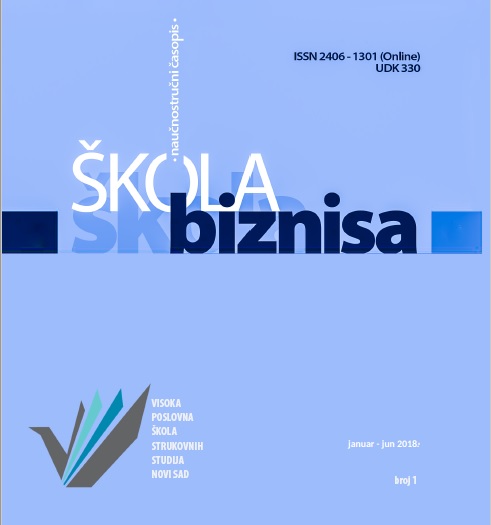PLACEMENT OF DOMESTIC GASTRONOMIC PRODUCTS IN TOURISM - CHALLENGES AND CHANCE
Abstract
Approximately 30% of tourist costs are allocated for the consumption of food and beverages, and often more in the case of local agricultural products. Therefore, the subject of research is to examine the links between domestic produced agricultural products and tourism on specific examples. In the first phase of the research focus is on examples of good and bad practice from different continents. The central task was to examine the situation of the mentioned topics in Serbia. For the case study is taken Srem District. Through the questionnaire, the views of local agricultural producers in Srem regarding the placement of their products were examined (who are their customers, whether the hotels/restaurants are interested in buying their products, whether they know how to sell their products to restaurants/hotels, there are some difficulties in such a sales chain (placement of goods), etc. In addition to the historical method, descriptive statistics (SPSS 17) have been used. The results of the survey provide an insight into the current situation and provide concrete guidelines for improving the cooperation of the tourism sector and the local community with positive multieffects to high number of stakeholders.
References
Alegre, J., & Garau, J. (2010). Tourism satisfaction and dissatisfaction. Annals of Tourism Research, 37(1), 52-73. doi:10.1016/j.annals.2009.07.001
Antić, A., Vujko, A., Gajić, T. (2015). Tradicija kao pokretač razvoja turizma ruralnih destinacija. Škola biznisa. Visoka poslovna škola strukovnih studija, Novi Sad, 2, 9-20.
DOI 10.5937/skolbiz2-10357
Beerli, A., & Martin, J. D. (2004). Factors influencing destination image. Annals of Tourism Research, 31(3), 657-681. https://doi.org/10.1016/j.annals.2004.01.010
Cohen, E. (1979). A phenomenology of tourist experiences. Sociology, 13(2), 179-201.
Cox, L. J., Fox, M., Bowen, R.L. (1994). Does Tourism Destroy Agriculture? Annals of Tourism Research, 22, 210-213.
Crompton, L. (1979). An assessment of the image of Mexico as a vacation destination and the influence of geographical location upon that image. J Travel Res, 17, 18-23. doi: 10.1177/004728757901700404
Deđanski S., Puzić G. (2010). Menadžment razvoja vinskog turizma u Srbiji kao osnova razvoja lokalnih zajednica. Ekonomika poljoprivrede, 57 (3), 463-473.
FARMA (June 2006). Sector Briefing - Farmers Markets in the UK. Nine Years and Counting. FARMA, Southampton.
Hall C. M. & Mitchell, R. (2001). Wine and food tourism. Wiley, Sydney.
Hall C. M. & Mitchell R. (2006). Gastronomy, food and wine tourism. Elsevier Ltd, Oxford.
Hall, C.M. & Sharples, L. (2003). The consumption of experiences or the experience of consumption? An introduction to the tourism of taste in Food tourism around the world. Elsevier Butterworth-Heinemann, Oxford.
Hall, C.M. (2005). Rural wine and food tourism cluster and network development. In book Rural tourism and sustainable business. Channel View Publications 149-164
Hosany, S., Ekinci, Y. & Uysal, M. (2006). Destination image and destination personality: An application of branding theories on tourism places. Journal of Business Research, 59, 638-642.
Hjalager, A. & Richards, G. (2002). Tourism and Gastronomic. London: Routledge.
Kim, J. K. (2014). The antecedents of memorable tourism experiences: The development of a scale to measure the destination attributes associated with memorable experiences. Tourism Management, 44, 34-45.
Meyer, D., Ashley, C. & Poultney, C. (2004). Pro Poor Tourism Pilots Programm - Business Implementation of Pro Poor Tourism: Case Study Briefs (No. 3: Tourism-agricultural link: Boosting inputs from local farmers).
DFID's Business Linkages Challenge Fun.
New Economics Foundation (2001). Local Food Shopping better for Rural Economy than Supermarket Shopping. Preuzeto 6. juna 2015. Sa http://www.neweconomics.org/gen/m6_i121_news.aspx).
OECD (2009). The Impact of Culture on Tourism. Paris: OECD.
Pivac, T. (2012). Vinski turizam Vojvodine. Prirodno-matematički fakultet, Departman za geografiju, turizam i hotelijerstvo, Novi Sad.
Pivac, T., Dragin, A., Dragićević, V. & Vasiljević, Đ. (2016). Selektivni oblici turizma – primeri dobre prakse u svetu i stanje u Republici Srbiji. Prirodno-matematički fakultet, Departman za geografiju, turizam i hotelijerstvo (Univerzitet u Novom Sadu).
Rankov, S. (2017). Sertifikaciono telo za sertifikaciju proizvoda sa oznakom geografskog porekla. Enološka Stanica Vršac, Vršac.
Telfer, D.J.& Wall, G. (1996). Linkages Between Tourism and Food Production. Annals of Tourism Research, 23 (3), 635-653. doi: 10.1016/0160-7383(95)00087-9
Torres, R. (2004). Challenges and Potential for Linking Tourism and Agriculture to Achieve Pro-Poor Tourism Objectives. Progress in Development Studies, 4(4), 294-318.
Tsai, S.C.T., Wang, Y.C. (2017). Experimential value in branding food tourism. Journal of Destination Marketing & Management, 6, 56-65. http://dx.doi.org/10.1016/j.jdmm.2016.02.003
Vujko, A., Petrović, M., Dragosavac, M., Ćurčić, N., Gajić, T. (2017). The linkage between traditional food and loyalty of tourists to the rural destinations. Teme, 41(2), 475-487. doi:10.22190/TEME1702475V
Quan, S. & Wang, N. (2004). Towards a structural model of the tourist experience: An illustration from food experiences in tourism. Tourism management, 25(3), 297-305. http://dx.doi.org/10.1016/S0261-5177(03)00130-4
World Tourism Organization (2012a). Global Report on Food Tourism. UNWTO, Madrid.
World Tourism Organization (2012b). Global Report on Food Tourism. UNWTO, Madrid
http://www.cabi.org/Uploads/CABI/OpenResources/39762/Chap8/Ch8_Essay.pdf
http://www.zis.gov.rs/prava-intelektualne-svojine/oznake-geografskog-porekla/spisak-ogp.953.html
http://www.novosti.rs/vesti/naslovna/ekonomija/aktuelno.239.
html:521405-Zasticena-samo-tri-srpska-brenda
http://www.srbija.travel/destinacije/putevi-vina/
http://www.srbija.travel/?s=srem&x=0&y=0&lang=sr
http://www.srbija.travel/kalendar-dogadjaja/
www.visitkorea.or.kr
- Authors retain copyright and grant the journal right of first publication with the work simultaneously licensed under a Creative Commons Attribution License that allows others to share the work with an acknowledgement of the work's authorship and initial publication in this journal.
- Authors are able to enter into separate, additional contractual arrangements for the non-exclusive distribution of the journal's published version of the work (e.g., post it to an institutional repository or publish it in a book), with an acknowledgement of its initial publication in this journal.
- Authors are permitted and encouraged to post their work online (e.g., in institutional repositories or on their website) prior to and during the submission process, as it can lead to productive exchanges, as well as earlier and greater citation of published work (See The Effect of Open Access).

